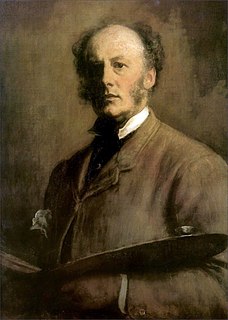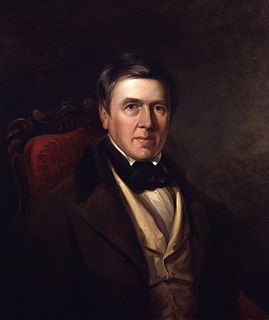
Sir John Everett Millais, 1st Baronet, was an English painter and illustrator who was one of the founders of the Pre-Raphaelite Brotherhood. He was a child prodigy who, aged eleven, became the youngest student to enter the Royal Academy Schools. The Pre-Raphaelite Brotherhood was founded at his family home in London, at 83 Gower Street. Millais became the most famous exponent of the style, his painting Christ in the House of His Parents (1849–50) generating considerable controversy, and he produced a picture that could serve as the embodiment of the historical and naturalist focus of the group, Ophelia, in 1851–52.

David Cox was an English landscape painter, one of the most important members of the Birmingham School of landscape artists and an early precursor of Impressionism.

Samuel Palmer Hon.RE was a British landscape painter, etcher and printmaker. He was also a prolific writer. Palmer was a key figure in Romanticism in Britain and produced visionary pastoral paintings.

The Royal Birmingham Society of Artists or RBSA is an art society, based in the Jewellery Quarter in Birmingham, England, where it owns and operates an art gallery, the RBSA Gallery, on Brook Street, just off St Paul's Square. It is both a registered charity, and a registered company.

William Gear RA RBSA was a Scottish painter, most notable for his abstract compositions.

Edward Robert Hughes was an English painter who worked prominently in watercolours, but also produced a number of significant oil paintings. He was influenced by his uncle and eminent artist, Arthur Hughes who was associated with the Pre-Raphaelite Brotherhood, and worked closely with one of the Brotherhood's founders, William Holman Hunt.

Joseph Edward Southall RWS NEAC RBSA was an English painter associated with the Arts and Crafts movement.

Joseph Vincent Barber (1788–1838), known as Vincent Barber, was an English landscape painter and art teacher.
Joseph Barber was an English landscape painter and art teacher, and an early member of the Birmingham School of landscape painters.
Charles Vincent Barber was an English landscape painter and art teacher.

Samuel Lines was an English designer, painter and art teacher, and an early member of the Birmingham School of landscape painters.

Samuel Rostill Lines was an English painter and illustrator.

Samuel Henry Baker (1824–1909) was an English landscape artist. He was a member of the Royal Birmingham Society of Artists (RBSA) and the Royal Society of Painter-Etchers and Engravers (RE). He painted rural landscape scenes in watercolour.

Birmingham has a distinctive culture of art and design that emerged in the 1750s, driven by the historic importance of the applied arts to the city's manufacturing economy. While other early industrial towns such as Manchester and Bradford were based on the manufacture of bulk commodities such as cotton and wool, Birmingham's economy from the 18th century onwards was built on the production of finished manufactured goods for European luxury markets. The sale of these products was dependent on high-quality design, and this resulted in the early growth of an extensive infrastructure for the education of artists and designers and for exhibiting their works, and placed Birmingham at the heart of debate about the role of the visual arts in the emerging industrial society.
William Thomas Roden was a nineteenth-century English artist.

The Birmingham School was a group of landscape artists working in Birmingham, England in the late 18th and early 19th centuries; descending from Daniel Bond, who was active in the 1760s, and including well-known later figures such as Thomas Creswick, Thomas Baker and David Cox, who was to become an early precursor of impressionism.

Henry Harris Lines was a landscape artist and archaeologist, and the eldest son of Birmingham artist and drawing master Samuel Lines (1778–1863). There are a number of Henry's works stored in the permanent collections of various provincial museums and art galleries including Birmingham Museum and Art Gallery, Worcester City Art Gallery and Museum and the Royal Birmingham Society of Artists (RBSA) Gallery. As well as at the Birmingham Society of Arts, Henry also exhibited at the Royal Academy, British Institution and Society of British Artists. The Wright family's patronage of the Lines family is also evident in William Rostill Lines's sculpture Bust of Mr. Thomas Wright Hill that was exhibited at the Birmingham Society of Arts Exhibition in 1829.

The Williams family of painters, also known as the Barnes School, is a family of prominent 19th-century Victorian landscape artists known for their paintings of the British countryside, coasts and mountains. They are represented by the artist Edward Williams (1781–1855), his six sons, and several grandchildren.

Frederick Thomas Lines was an English portrait painter in addition to experimenting in studies from nature and landscape. Lines was known to be a master of the medium of watercolour.

William James Neatby often W.J.Neatby was an English architect, designer and artist. He is best known for his designs of architectural ceramics and was Doulton and Co.'s chief ceramic designer. His stand our works include the Meat Hall in Harrods (London), and Everard's Printing Works (Bristol). The Modern Style of the Everards Printing Works facade is the largest decorative Doulton Carrara ware tile facade of its kind in Britain. Neatby was among leading British artists during the late 19th and early 20th century. Ernest Augustus Runtz said of him: "He was a true artist, and a man of fine character, and he pursued his art with a direct and single purpose."
















